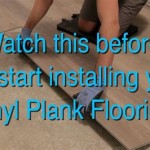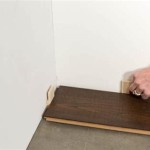New Flooring Options 2024: A Comprehensive Overview
The flooring industry is consistently evolving, with new materials, technologies, and design trends emerging each year. For 2024, several key innovations are poised to reshape the landscape of residential and commercial flooring. Understanding these advancements is crucial for homeowners, contractors, and interior designers alike, enabling informed decisions about durability, aesthetics, sustainability, and cost-effectiveness. This article provides a detailed exploration of the notable new flooring options available in 2024.
One significant trend is the increased emphasis on sustainability and eco-friendly alternatives. Consumers are becoming more environmentally conscious, demanding flooring options that minimize environmental impact. This demand has spurred innovation in recycled materials, bio-based polymers, and manufacturing processes that reduce waste and energy consumption. Simultaneously, advancements in manufacturing techniques are leading to improved performance and aesthetics across a broader range of flooring types.
Durability and performance remain paramount considerations. Flooring must withstand daily wear and tear, moisture, temperature fluctuations, and varying levels of foot traffic. Manufacturers are addressing these challenges by developing enhanced protective coatings, more robust core materials, and installation methods that improve long-term stability. The result is flooring that not only looks appealing but also provides lasting value and reduces the need for frequent replacement.
Aesthetic preferences are also constantly shifting. Current trends favor natural textures, realistic visuals, and adaptable designs that complement diverse interior styles. The latest flooring options reflect these trends with a wide array of colors, patterns, and finishes that cater to both contemporary and traditional tastes. Moreover, technological advancements in printing and embossing are enabling manufacturers to replicate the look and feel of natural materials with remarkable accuracy.
Waterproof and Water-Resistant Flooring Advancements
Waterproof and water-resistant flooring have become increasingly popular due to their versatility and suitability for areas prone to moisture, such as kitchens, bathrooms, and basements. In 2024, significant advancements are being made in this category, focusing both on new materials and improved manufacturing processes.
Luxury Vinyl Plank (LVP) and Luxury Vinyl Tile (LVT) remain a dominant force in waterproof flooring. However, the latest iterations feature enhanced cores and thicker wear layers, providing improved dent resistance and overall durability. Some manufacturers are incorporating mineral cores, which offer superior dimensional stability and resistance to expansion and contraction due to temperature changes. This makes LVP and LVT suitable for installation in areas with significant temperature fluctuations, such as sunrooms or homes in climates with extreme weather conditions.
Another notable development is the introduction of waterproof laminate flooring. Traditional laminate has always been susceptible to water damage, but new technologies are addressing this limitation. These waterproof laminates feature tightly sealed seams and water-resistant cores, preventing moisture from penetrating the flooring. While not entirely impervious to prolonged submersion, they offer excellent protection against spills, splashes, and everyday moisture exposure. This makes waterproof laminate a viable alternative to LVP and LVT in certain applications, providing a more budget-friendly option with the aesthetic appeal of wood.
Beyond vinyl and laminate, waterproof wood flooring is also gaining traction. This typically involves treating real hardwood with a proprietary sealant and employing tight-locking installation systems to minimize water penetration. Although more expensive than vinyl or laminate, waterproof wood flooring offers the authentic look and feel of hardwood with enhanced moisture resistance. This is particularly appealing to homeowners who desire the warmth and elegance of wood but are concerned about potential water damage.
The advancements in waterproof flooring extend beyond the materials themselves. Improved installation methods, such as enhanced locking systems and waterproof adhesives, further contribute to the overall performance and reliability of these flooring options. These advancements ensure that even if the flooring material itself is waterproof, the installation process does not compromise its integrity.
Sustainable and Eco-Friendly Flooring Choices
The demand for sustainable and eco-friendly flooring is driving innovation across the industry. Manufacturers are exploring new materials, manufacturing processes, and sourcing practices to minimize environmental impact and meet the growing demand for green building alternatives.
Recycled content is a key feature of many sustainable flooring options. Recycled rubber flooring, often made from recycled tires, is a durable and resilient choice for gyms, playrooms, and other high-impact areas. Recycled glass tile is another option, offering a unique aesthetic and contributing to waste reduction. Some manufacturers are also incorporating recycled plastics into the core layers of LVP and LVT, further reducing the reliance on virgin materials.
Bio-based materials are also gaining popularity. These materials are derived from renewable resources, such as bamboo, cork, and linoleum. Bamboo flooring is known for its rapid growth and renewability, making it a sustainable alternative to hardwood. Cork flooring is harvested from the bark of cork trees, which regenerates over time, ensuring a continuous supply of the material. Linoleum is made from natural ingredients, including linseed oil, cork dust, wood flour, and rosin, making it a biodegradable and environmentally friendly option.
Sustainable manufacturing practices are also playing a crucial role. Manufacturers are implementing strategies to reduce waste, conserve energy, and minimize emissions. This includes using closed-loop manufacturing systems, which recycle waste materials back into the production process, and investing in energy-efficient equipment and renewable energy sources. Certifications such as LEED (Leadership in Energy and Environmental Design) and FloorScore provide independent verification of sustainable practices and materials, helping consumers make informed choices.
Beyond the materials themselves, the adhesives and finishes used on flooring can also impact sustainability. Low-VOC (volatile organic compound) adhesives and finishes are essential for minimizing indoor air pollution and promoting a healthy living environment. These products release fewer harmful chemicals into the air, reducing the risk of respiratory problems and other health issues.
Innovative Materials and Designs
The flooring industry is constantly pushing the boundaries of innovation, with new materials and designs emerging to meet evolving aesthetic and functional requirements. These advancements are transforming the way we think about flooring, offering new possibilities for customization, performance, and visual appeal.
One exciting development is the use of digital printing technology to create highly realistic visuals on flooring. This technology allows manufacturers to replicate the look and feel of natural materials, such as wood, stone, and tile, with remarkable accuracy. Digital printing can also be used to create custom designs and patterns, offering endless possibilities for personalization. This is particularly useful for commercial applications, where branding and unique design elements are often desired.
Another innovation is the incorporation of advanced surface coatings that enhance durability and stain resistance. These coatings, often based on nanotechnology, provide a protective layer that repels dirt, liquids, and scratches. This makes flooring easier to clean and maintain, reducing the need for harsh chemicals and frequent maintenance. Self-healing coatings are also being developed, which can repair minor scratches and abrasions, further extending the lifespan of the flooring.
Hybrid flooring is another notable trend, combining the best features of different flooring types into a single product. For example, some hybrid flooring options combine the waterproof properties of LVP with the rigid core of laminate, resulting in a durable and water-resistant flooring solution with enhanced dimensional stability. These hybrid products offer a versatile and convenient alternative to traditional flooring options.
Textured flooring is also gaining popularity, adding depth and visual interest to interior spaces. Embossed textures can replicate the grain of wood, the texture of stone, or the feel of fabric, creating a more tactile and engaging experience. These textures can also improve slip resistance, making flooring safer for areas with high foot traffic or where spills are common.
Finally, the increasing use of modular flooring systems is transforming the way flooring is installed and maintained. Modular tiles and planks can be easily replaced or rearranged, allowing for quick and cost-effective repairs or renovations. This is particularly beneficial for commercial spaces, where downtime can be costly.

Innovate Fantastic Flooring Ideas For 2024

Top Kitchen Flooring Trends 2024 Stylish Options

The Hottest Bathroom Flooring Ideas For 2024

Top 5 Popular Kitchen Flooring Options For 2024 Trends Wall Curtains

Top Kitchen Flooring Trends 2024 Stylish Options

5 Best Laminate Flooring Options In 2024 Wood And Beyond Blog

The Best Open Plan Flooring Options In 2024 Wood And Beyond Blog

Flooring Trends 2024 12 Best Options For

Top Wood Flooring Trends For 2024 Arrant Construction

Best Vinyl Plank Flooring Top 5 Options In 2024 Wood And Beyond Blog
Related Posts








